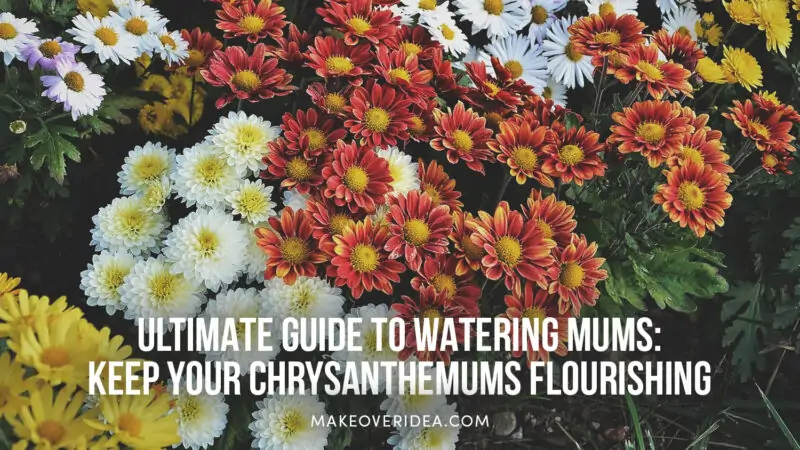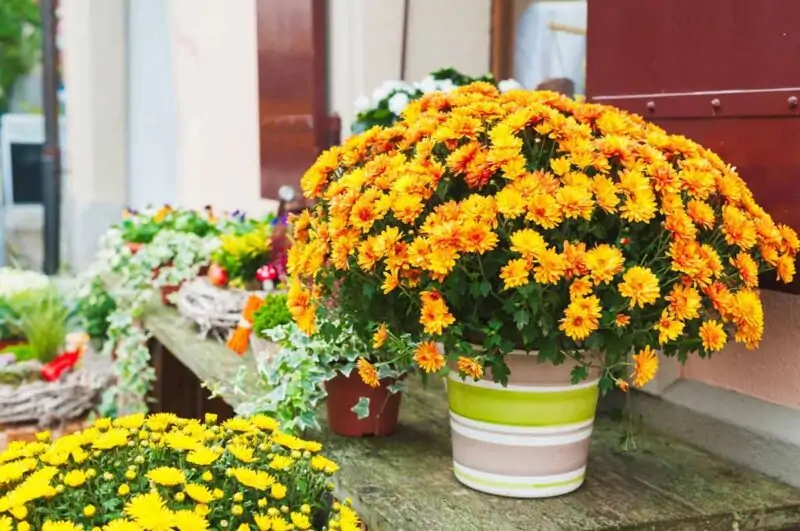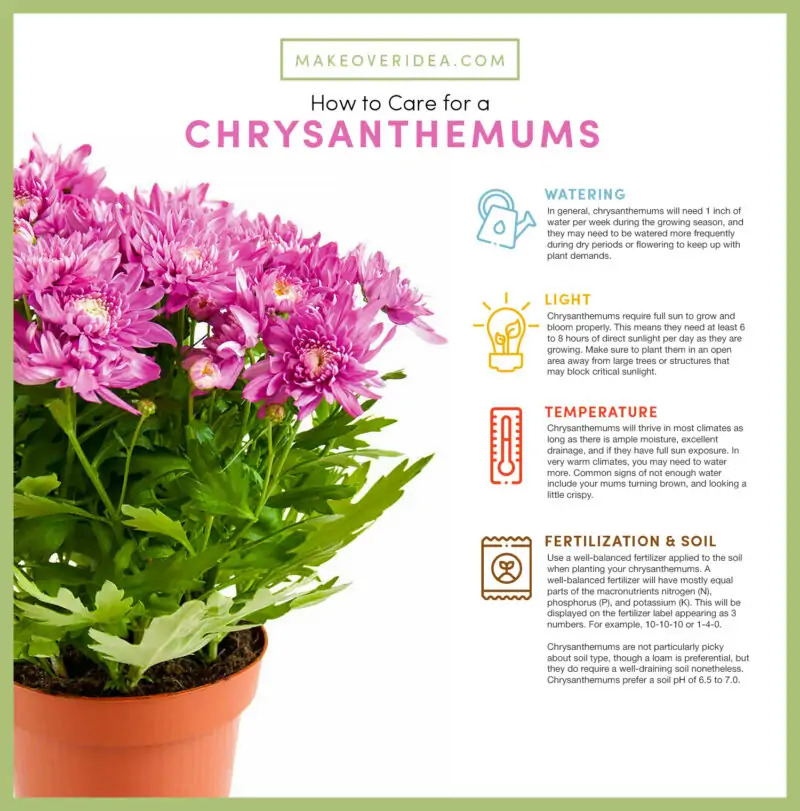How Often to Water Mums: Keep Your Chrysanthemums Healthy

Are you a proud owner of beautiful chrysanthemums, or mums as they are commonly known? These gorgeous flowers come in various colors and types, making them one of the most popular choices for gardens and pots. However, if you want your mums to bloom their best and last longer than usual, it’s essential to know how often to water them.
In this article, we’ll discuss everything about watering mums – from factors affecting frequency to signs of overwatering or underwatering. Let’s get started!
Getting To Know Your Mums
Before diving into watering tips for your chrysanthemum plants, let’s understand what Chrysanthemum is all about.
What Are Chrysanthemums?
Chrysanthemums are flowering plants that belong to the Asteraceae family. They originated in East Asia but have become popular across countries throughout Europe and America since then.
You can find hardy garden varieties available at garden centers, while indoor varieties may be potted with full blooms year-round!
Types Of Garden Mums
There are hundreds of individual mum cultivars out there; however, when looking broadly speaking, there are two main groups:
- Hardy/Outdoor Varieties – Perfectly suited for outdoor conditions, these toughies will survive through frosts even up until snowfall!
- Indoor/Potted Varieties – Indoor versions that thrive indoors all year round, flowering throughout most months except wintertime.
How Often To Water Mums?

The general rule of thumb when watering chrysanthemums as well as any type of flowers is no different here: avoid under-watering by keeping the soil moist while ensuring not to over-saturate the soil either!
Factors Affecting Water Frequency
Several aspects determine how much water your mum needs:
Soil Type
Mums prefer well-draining soil with organic matter mixed in. Sandy soil needs to be watered more frequently than clayey and loamy soils.
Sun Exposure
Mums in full sun dry out faster, so they need watering more often than shaded ones.
Signs of Overwatering or Underwatering
- Over-watering can cause root rot leading to wilting flowers and foliage that feels slimy rather than healthy green.
- Under-watering, on the other hand, leads to wilted leaves with brown edges- this is a sign your mum isn’t receiving enough moisture through roots.
Special Care for Potted Mums
Whether you’re growing mums indoors or outdoors in pots, there are some things you should keep in mind.
Watering Mums In Pots: How Often?
Potted mums require frequent watering since their roots cannot reach the ground’s natural moisture source – they are stopped by the bottom of the pot. However, it’s always best not to overdo it! A good rule of thumb would be regularly checking the soil for dampness by inserting fingers into the potting soil down around an inch to find out whether your chrysanthemum has to cope with dry soil.
Proper Drainage And Repotting Tips
Make sure your pot has small drainage holes at the bottom, allowing excess water to escape from within after each time plants have been hydrated properly without sitting too long within stagnant areas! If these conditions aren’t met, promptly repot into larger containers, improving drainage efficiency.
Seasonal Considerations For Watering Mums
Since fall is when we typically see many gardens filled with beautiful blooms, know that during autumn, temperatures drop greatly compared to summer months, which means fewer sunlight hours per day – resulting in slower growth patterns throughout cooler days ahead!
As temperatures decrease, make sure the hydration schedule adapts accordingly – whereas hotter periods might demand daily drinks to maintain healthy, happy plants thriving all season long!
How Often To Water Mums In Fall?
During cool temperatures, mums need less frequent watering. Water them every 2-3 days or when the soil appears dry.
Adjusting Watering Schedule Based On Sun Exposure
With fewer sunlight hours available during the fall season, additional watering may be required to ensure optimal growth of buds into blooms! Be proactive in your plant care by regularly checking moisture levels while adjusting the frequency and duration of watering accordingly!
Chrysanthemum Care Tips

Hardy Mums vs Non-Hardy Mums
Hardy mums are perennials that can withstand cold temperatures; non-hardy types will not survive frost exposure beyond winter months but still make a great addition to those indoor spaces looking for colorful focal points all year round!
Overwintering Chrysanthemums
If you want your chrysanthemum plant babies’ flowers to bloom again next season, follow these tips:
- In Autumn, cut back foliage so only an inch remains above the soil level.
- Add mulch around the base of plants to keep roots warm throughout colder times ahead!
FAQs
It depends on the pot size and type of mum variety. Check daily until you get used to knowing how much liquid keeps it moist enough without overwatering, causing root rot! You might also want to consult with the gardeners in your local nursery about whether your mums are underwatered.
Mums require regular hydration, or else they’ll wilt under scorching sun rays! A good rule of thumb is never to let the soil dry out completely between drinks; however, avoid constant saturation as well.
Mums planted in full sunshine typically demand more frequent drink breaks since their leaves absorb large amounts of heat from the day’s hottest moments, dehydrating faster than shaded counterparts.
As temperatures decrease, so does the frequency of watering mums. Aim for every 2-3 days when the soil feels dry.
Hardy chrysanthemums are perennials, whereas non-hardy varieties work as annuals in colder regions where frosts kill them off during winter months.
Mums require full sun exposure (approximately six hours) to bloom properly and grow strong! However, some indoor or more shaded varieties can still thrive with less sunlight throughout the day.
Mum’s leaves will begin wilting if they aren’t receiving enough moisture through roots, while waterlogged root rot may occur when overwatering occurs, leading to slimy foliage that looks unhealthy instead of fresh and green!
Conclusion
Now you know how important it is to get your mum’s hydration right! Proper watering intervals and drainage efficiency adjusted accordingly seasonally provide optimal growth conditions affecting overall health blooms.
Keep these tips handy whenever caring for any variety of chrysanthemum plant babies, pot-bound or garden planted, no matter the hardiness levels – avoid under-watered dehydration and over-saturated roots, bestowing upon your plants happy, healthy lives filled with beautiful flowers all year long!